Featured
Kia’s President Brings Toyota-like Confidence: Editor’s Letter
 Ho Sung Song has led a dramatic brand reinvention since he took the reins in 2020
Ho Sung Song has led a dramatic brand reinvention since he took the reins in 2020
Despite being vast industrial global companies, car makers can still have the impact of an individual felt.
Toyota is a great example, the premiership of the effervescent Akio Toyoda throughout the 2010s adding a previously unimaginable human side to this most corporate of car firms.
The main figure at the heart of Kia’s rise this century was designer Peter Schreyer, who was positioned as de facto leader of the company and successfully moved the Korean firm from a dowdy budget brand to a more aspirational mainstream one.
Kia now has another charismatic individual moving it forward again: Ho Sung Song, Kia's president and CEO.
He took the top job in 2020 after 13 years at the company and has overseen a new brand image that’s shaken Kia’s budget feel for good. Song has used the introduction of EVs to go even bolder; the likes of the EV6 and EV9 can see off far more costly and staid rivals, while the EV3 feels good enough to become a Volkswagen Golf-style default choice in the electric era.
Kia is making BMWs for the people (its latest design boss Karim Habib is formerly of Munich…) while still very happy to fill the void left by Ford in making cars at volume. More impressively, Kia’s ceiling for making larger and more expensive cars that people are willing to buy and can be sold profitably feels much higher than Ford’s.
It’s easy to see why Kia has so much confidence when you spend time in Song’s company. Friendly and hospitable, Song will answer questions honestly and directly and knows how the world works outside Korea; his stints in several major global markets including the UK for his previous employer Hyundai helped shape that.
Tariffs on Chinese-made electric cars imported into the EU are “fair game” to counter state support, while the UK’s controversial mandate on the sale of electric cars is a good thing in Song’s eyes as it ultimately forces the market. He sees city cars as an essential part of a manufacturer’s offering to ensure cars are accessible and affordable in the electric era, so is desperate to launch a sub-€20,000 model by 2030.
He’ll just as happily talk golf; like many Koreans, Song is a golf nut and plays to a single-digit handicap even as a CEO working 12-hour days.
‘Why not?’ often comes back as the response when further challenges or markets to enter are put to Song, but for now the next horizon is vans.
In January, Kia revealed plans for a new family of electric vans that will start to see production late next year, sold in dedicated van dealerships.
It's a good time and a good way to get into the van market, as while electric propulsion is the mandated future, it will stay a minority choice for longer than cars, due to cost and range issues in a sector where time on the road and total cost of ownership are everything.
While Europe is the focus for vans, they can have an impact elsewhere. When Song looks outside the window of his EV9 (he uses the massaging seats as an antidote to Seoul’s terrible traffic) he wouldn’t see a van at all, rather small trucks with different beds on the back and a cab on the front.
The likes of the Hyundai Porter and Kia Bongo are among Korea’s best-selling vehicles, yet crash safety regulations will kill them off from 2027, and Kia senses an opportunity here for the likes of the PV5, too. Something will need to replace them, and why not the PV5?
Kia can start small, learn and build as the electric van market grows, although taking on Ford here is perhaps Kia’s biggest task yet. Though as one company official told me, Kia’s goal is never to match the best, but to beat it.
McLaren Partner Neom: A Futuristic Tech City Resembling Holiday Inn Express in Glendale, CA

If you follow motorsports you’ve probably seen the word “Neom” somewhere. It’s pretty prevalent in trackside billboards, and it is the title sponsor of McLaren’s Formula E and Extreme E efforts. You might not, however, have known what Neom is. Aside from another avenue for Saudi Arabia to sportswash its horrific…

Tesla’s deals set to boost September EV sales to record levels

Model Ys are said to be piling up at Southampton docksThe Model Y can be had on lease for £299 per month as the brand gears up for a strong end-of-quarter push
September could be on course to be a record month for electric car sales in the UK after manufacturers, led by Tesla, increased the attractiveness of finance offers.
Car makers are scrambling to hit the target set by the zero-emission vehicle (ZEV) mandate that calls for 22% of new car sales to be electric this year. Some flexibility is available – for example, via increased sales of plug-in hybrids – but many key manufacturers including the Volkswagen Group, Ford, Toyota and the Renault Group are pushing hard to raise EV sales and avoid fines after selling significantly below their target in the first half of the year.
Discounts on the price of an electric car are running at around 9.6% – equivalent to an average of £5596 – the What Car? Target Price team calculated at the beginning of the month.
However, Tesla’s September push is the one that’s expected to really move EV sales in the plate-change month, with an eye-catching personal lease offer of £299 a month on the Model Y. The Y is the UK’s biggest-selling electric model this year to the end of August, according to SMMT figures.
Tesla’s direct-sales model fixes the price of the cars but the US company has more flexibility when it comes to finance, hence the generous three-year, 30,000-mile deal. With the down payment, it works out at £424 a month, less than the price of Hyundai’s lease deal on a Kona small electric SUV with the 65kWh battery. The Model Y is two classes bigger than the Hyundai.
To take advantage of the offer, Tesla buyers must take delivery before of the end of the month, which also marks the end of the financial quarter for the company. Tesla ships in stock and typically buyers pick up the cars from whichever dealer holds the car closest to the spec the customer requires.
One buyer posting on Reddit this week noted the number of Model Ys at Southampton Docks, where they picked up their new car. “I was amazed at how many cars there were, firstly in a multi-storey, and then in two big car parks on either side of the road running through the docks area,” the buyer wrote.
A big push from Tesla can easily lift overall EV sales, as we saw in August. The Model 3 and Model Y were the two biggest-sellers in what was a record EV month, pushing the brand to first place in the electric charts and outselling second-placed BMW by two to one. That contrasted with July, when BMW was the top EV seller, both in the UK and across Europe.
Last month, electric registrations hit 23% of overall car sales, according to the SMMT, making it the first month the UK exceeded its EV target for the year.
September could be on course to be only the second month in the UK to break the 50,000 mark for EV sales. September is typically a big sales month, like March, due to the numberplate change. The record EV sales month was March 2022, with 52,200 sold.
Steep discounts along with generous company car incentives are helping to overcome buyer wariness of EVs. Retail discounts being offered include £6750 off the price of a new Audi Q4 E-tron if the buyer chooses the PCP finance deal. Audi was the leading discounter overall across all fuels, according the September What Car? Target Price report, at an average discount of £8553 per car.
Other electric deals include £3500 off the new price of a Honda e:Ny1, again linked to a PCP deal.
Generous personal leasing deals for electric cars are evident on aggregator sites such as leasing.com. Offers there at the time of writing included £277 a month for a Vauxhall Astra Sports Tourer EV with £833 down on a three-year deal at 10,000 miles a year. On the same terms, the Lexus RZ 450e was available for £481 a month with zero down payment, putting it close to the Tesla Model Y on price. More Lexus EV sales will help owner Toyota achieve its overall target.
Dealer group Vertu reported in early September that electric vehicle supply “remains strong” as car makers seek to boost their EV share. However, the group also said that profit margins have been put under pressure from “significant discounting”. Vertu, which incorporates Bristol Street Motors, has claimed car makers are throttling back combustion-engine vehicle supply to help them hit EV targets.
Stellantis has publicly criticised the UK's ZEV mandate for 2024, although significantly CEO Carlos Tavares has not joined the European automotive lobby group in calling for flexibility in the 2025 European Union CO2 restrictions, which require more EV sales to meet the new target. Next year, car makers such as Stellantis will have more budget EVs on sale, closing the price gap to combustion-engine models.
Seattle Airport Data Ransom: Hackers Demand $5.7M | Giga Gears

Hackers attacked Seattle-Tacoma International Airport and the Port of Seattle last month, stealing roughly three terabytes of data while snarling ticketing and baggage systems. Airport officials stated today that it won’t pay the 100-bitcoin (or $5.7 million) ransom to prevent the stolen information from being posted…

“Classic Recipe: Ferrari Roma and 275 GTS Unite | Giga Gears”

275 GTS cost £5973 in 1965; Roma Spider is £210k todayRoma Spider can trace its roots back 60 years to the car that revolutionised rag-top Ferraris
Not good. I’ve selected first in the 275 GTS’s open gate and tried to pull away but the car won’t budge. Back into neutral, then into gear again: build revs, release clutch… Still nothing.
I feel the car’s transmission loading but its handsome Borranis will not rotate one inch. Must be something I’ve done, but I replay in my mind the drive we’ve just had – a steady 60mph cruise on an open A-road, with very little need to brake or even change gear – and it doesn’t equate.
A quick call to the GTS’s keeper, though, and, 20 minutes later, utter relief: when I’d backed into this pub car park to get my bearings, the rear brake pads, which have a habit of expanding when warm, locked onto their discs, rendering the car immobile.
While I’d been waiting they’d cooled, and £1.5 million worth of classic Ferrari was once again good to go.
I dare say that such a faux pas would never beset the Roma Spider that has joined us today. We’ve brought together these two Ferraris – the 275 from 1964, the open Roma launched in the UK this year – because between them they bookend a 60-year period during which Maranello produced some of its most memorable front-engined drop-top cars.
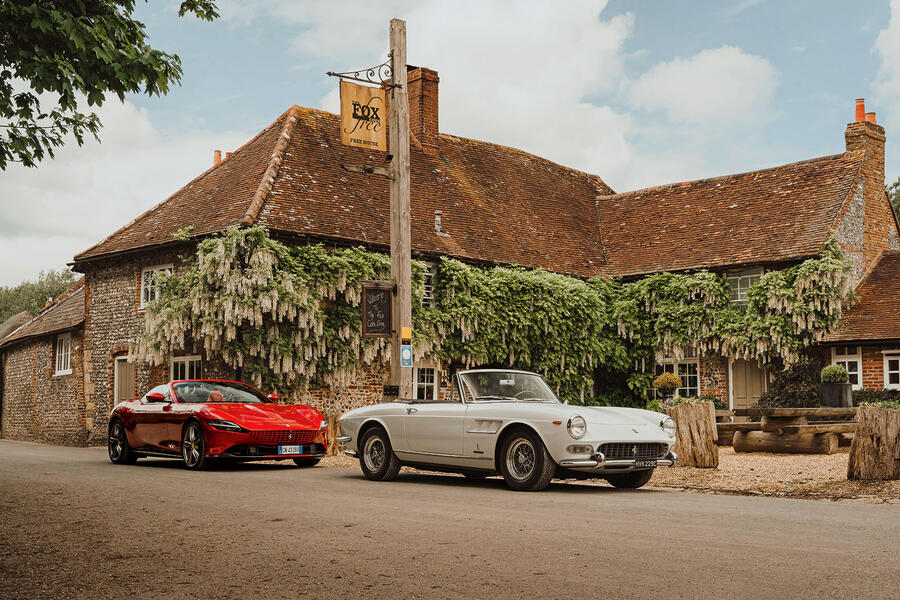
But this coming together marks more than just a convenient anniversary. Like the 275 did back in its day, the Roma Spider has moved the game on substantially from its predecessor, in terms of both design and technology.
That car, the Portofino M, could trace its roots back to the 2008 California via the 2014 California T. But the Roma Spider reintroduces something absent on a Ferrari since the 1969 365 GTS/4 ‘Daytona Spider’: a fabric roof.
Before I’m corrected, yes, the 550 Maranello-based Barchetta from 2000 had one too, but it was a mere get-you-home-in-the-wet appendage that would have done Heath Robinson proud.
The Roma Spider’s, however, is a proper eight-layered item, electrically raised and lowered with balletic precision in 13.5sec at speeds of up to 37mph.
It’s also designed to cope with a near-200mph top speed, and while the Daytona Spider wasn’t so far behind on that front (174mph, according to Ferrari), I’d imagine that hood and car would have been ready to part company at such a velocity.
We actually drove the Roma Spider in Italy last September, so its presence here today is more about providing a current reference point for the story. But just to recap, this is the long-awaited open-top addition to the Roma range, which launched with the coupé in 2020.
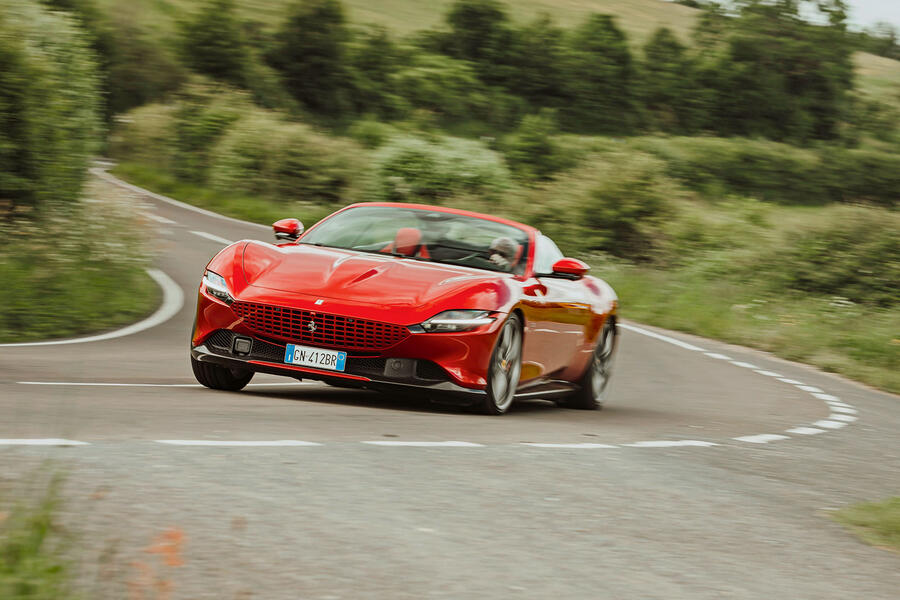
Priced at £210,838 (a £25k premium over the coupé), it uses the same twin-turbocharged, 3855cc V8 to deliver drive to the rear wheels through an eight-speed dual-clutch transmission, producing 612bhp from 5750rpm to 7500rpm.
Curiously, while its 1556kg dry weight adds only 84kg to that of the fixed-head Roma, it’s still a tad heavier overall than the outgoing Portofino M – and that despite having ditched its predecessor’s heavy and cumbersome retractable steel roof.
Nonetheless, it makes hardly a jot of difference to performance, with 62mph from rest arriving in 3.4sec and on to 124mph 6.3sec after that.
All of which would have confounded a 275 GTS driver back in the day. Launched with its 275 GTB (Berlinetta) sibling at the 1964 Paris motor show, it was the first open-top production Ferrari equipped with all-independent suspension – a departure from the live rear axle set-up that had underpinned the outgoing 250 family of models that included the much-lauded GT SWB and GTO.
There was also a transaxle for the first time (albeit with five ratios, rather than the Roma’s eight) to improve weight distribution. These were significant advances from Maranello at the time, and they would continued to underpin every subsequent model in the series right up to our Roma Spider.
This was a genuine case of Ferrari’s motorsport technology rapidly spilling over into its road cars, with the earlier front-engined 250 LM and 250 TR (Testa Rossa) racers both all-independently suspended, and the TR also using a transaxle.
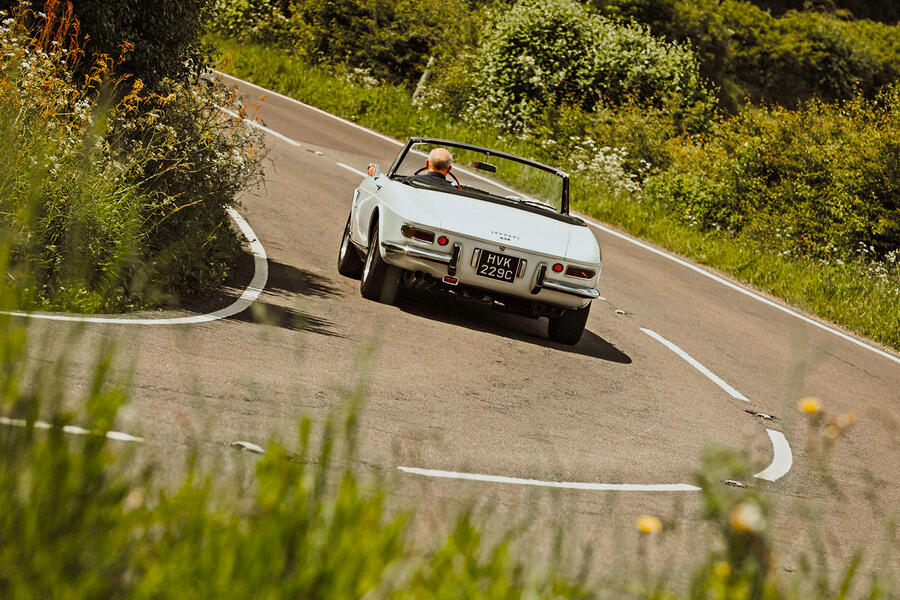
Enzo Ferrari may well have seen his road cars as cash cows to fund dominance in competition, but the engineering synergies certainly did no harm in improving either their drivability or their dynamic prowess.
All of which also explains why the 275’s 3.3-litre 60deg V12 engine was, in detuned form, also shared with many of Ferrari’s circuit cars. The legendary all-aluminium unit, designed by Gioacchino Colombo, was already a company staple in a wide variety of capacities.
For the first 275s, including the GTS, it was bored out from the 250’s 2953cc to 3286cc, with each cylinder displacing exactly 273.81cc – hence the 275 moniker.
In the GTS, this gave an output of 260bhp at a typically high 7000rpm. That’s 20bhp less than in the Berlinetta but befitting its slightly softer and more road-focused remit.
That still made the GTS an indecently fast car six decades ago. It could top 150mph and accelerate from 0-60mph in around 6.5sec. Then again, it weighed a relatively sylph-like 1120kg – 436kg less than today’s Roma Spider – despite its steel tubular-framed body being attached to a robust ladder-frame chassis.
And that body was a work of art. Designed and manufactured by Pininfarina (the GTB was also penned by Pininfarina, but it was built by Scaglietti), it was Ferrari’s first new convertible for two years, following the demise of the 250 GT California.
While it shared its platform and drivetrain with the 275 GTB, almost all of the open-top 275’s panels were unique, and at a stroke it banished the slight bulkiness of the Berlinetta with an almost petite and fine-lined two-seat body. Ferrari cues, such as the classic egg-crate grille and standard Borrani wire wheels, were all present and correct.
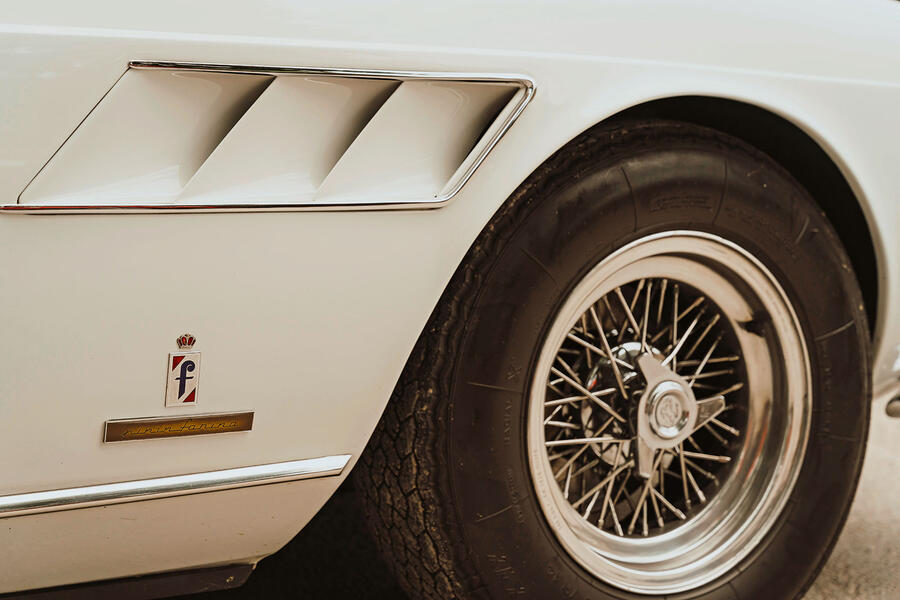
Parked here next to the Roma Spider, an in-house design by Ferrari’s Flavio Manzoni, the 275 looks somewhat overwhelmed. It’s near enough a foot shorter and narrower than its descendent, although the Roma does have the dubious advantage of two of the smallest rear seats I’ve seen in any car.
But given that these cars mark a six-decade evolution of Ferrari convertibles, it’s worth looking at what happened in the period in between – or rather what didn’t happen for nearly three decades.
During the 1960s, the convertible-Ferrari formula evolved in sync with successive hard-top launches: the 330 GTS and 365 California and GTS brought more power through bigger engine displacement, growing from the 275’s 3.3-litre unit to a 4.4-litre V12.
The cars also became larger and more opulent, in recognition of the importance of affluent American buyers to the brand’s profitability. For the front-engined convertibles, this reached its nadir in 1969 with the launch of the aforementioned 365 GTS/4 Daytona Spider.
This was a pinnacle car by any measure. Using the same 352bhp quad-cam 4.4-litre V12 that had previously powered the later 275 GTB/4, after the 275 GTS had been discontinued, it was, said Ferrari, the world’s fastest open production car.
But by then Fiat had taken a 50% stake in Ferrari, relieving Enzo of most road car responsibility, and the tide was turning for the traditional front-engined fare.
What followed was a mid-engined extravaganza from Maranello. It had already started with the launch of the 206 GT in 1967, but after the Daytona Spider ceased production in 1973, the only open-topped Ferraris available for the rest of the century – 308 GTS plus derivatives, Mondial Cabriolet, 348 GTS, 355 GTS/Spider and F50 – all had their engines mounted behind the driver. Only in 2000, with the low-volume 550 Barchetta Pininfarina, did Ferrari tentatively return with a front-engined, open-topped model (albeit one with an occasional roof).
It wasn’t until 2008 that the more ‘mainstream’ California entered the market, swapping V12 power for a naturally aspirated V8, before being comprehensively revised as the turbocharged California T six years later, and then again as the Portofino in 2017. The rather epic and still current 789bhp V12 812 GTS completed the list.
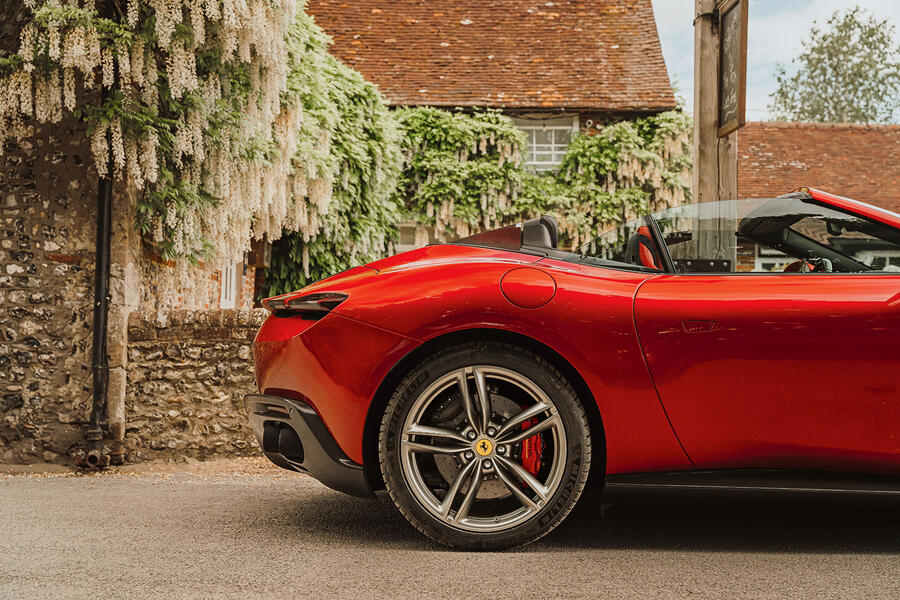
At least, until now. I’ll let our road testers give you their final verdict on how the Roma Spider drives on chronically surfaced UK roads in due course, but in the meantime, some observations.
First, sitting low in the Roma Spider’s driver’s seat, almost all controls, from the red manettino switch to the indicators, are on or around the flat-bottomed, carbonfibre and leather steering wheel. The layout does become intuitive very quickly, but the haptic buttons do not, and – to my eyes anyway – their appearance cheapens what is otherwise a beautifully crafted and ergonomically excellent cabin environment.
When deployed, the Roma’s fabric hood does a superb impression of a hard top in terms of noise and wind isolation, and with the highly effective wind deflector in place, the cabin remains bewilderingly refined when open. It raises the question: why buy the Roma coupé?
Then there’s the performance: it’s everything that you’d expect – but, as we’ll discover, the tone set by the Roma’s flat-plane crank V8 is put into stark perspective when you drive the 275.
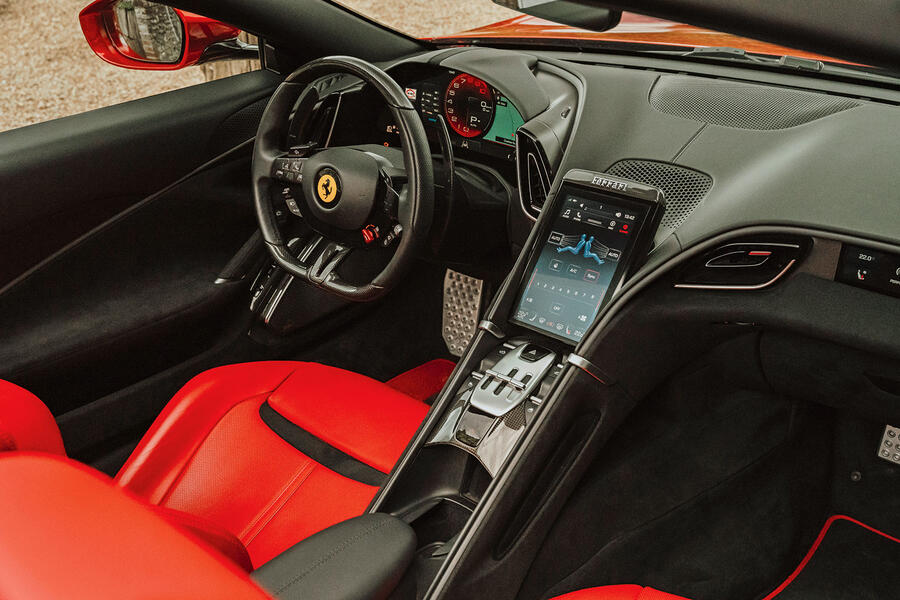
Finally, I do fully understand the rationale for automatic gearboxes in the quest for greater efficiency, and objectively there’s little to criticise about the Roma’s dual-clutch transmission, but for me, nothing touches a three-pedal, open-gated Ferrari.
So, here we are at nirvana. This 1965 275 GTS has been sourced by London Ferrari specialist Joe Macari from a very trusting client, and while the Ferrari Classiche-certified car is apparently due some recommissioning after being laid up for a while, it looks quite stunning.
Following the GTS in the Roma down to our photo locations around Goodwood, almost all passing moderns seem to dwarf it on the road. It cuts a glamorous swathe through South Downs villages, but you can’t help imagining how perfect this slice of la dolce vita would have looked motoring along Italian roads back in the day, the bark of its mighty Colombo V12 bouncing off the walls of lakeside trattorias.
Surprisingly, the ape-like driving position you expect to adopt in this mid-’60s Italian is nothing of the sort and everything falls to hand nicely. Dominating your view is a three-spoke, wood-rimmed Nardi steering wheel, behind which are a 300kph (186mph) speedometer, a tachometer redlined at 7000rpm and two smaller dials for oil pressure and temperature.
Four further dials, for water temp, charge, fuel and time run along the centre dash, with a bank of rocker switches below them.

Turn the key and wait for the V12’s three twin-choke Weber 40s’ float chambers to fill with super-unleaded, before the engine erupts with a sharp bark, coughs slightly, then catches on all cylinders.
With the roof down, the exhaust sounds near-unsilenced and all the better for it. Engage a dog-leg first with the long, kinked gearlever in its exposed chromium gate, release the heavy-ish clutch and you notice how responsive the long-travel throttle is.
Thank a well set-up bank of carburettors for that. Accelerate hard and you’re repaid with one of the all-time great automotive soundtracks: sonorous and deep-throated at lower revs, truly epic and spine-tingling in its upper reaches, it puts the Roma’s rather nondescript-sounding V8 to shame.
The engine is remarkably linear and flexible, too, pulling hard from around 2000rpm right up to its redline. The clutch is slightly worn on this car, but even so, there’s still something quite special about the clack-clack sound of the spindly lever inside its gate.

I’ve recently driven a couple of 275 GTBs, and the GTS is a little softer. Even so, it handles remarkably well for a 60-year-old convertible. There’s some scuttle and column shake, as you’d expect, but riding on correct 70-profile, 14in Michelin XWXs, it remains pliant enough to keep the worst shimmies in check.
Control is good at speed on awkward cambers, and the manual steering – a box, rather than a rack – is pleasantly high-geared and direct enough for committed driving yet not stupidly heavy at parking speeds.
Could you drive it to work every day, though? Of course not. Setting aside their value and now six decades of use, Ferraris of this era were never designed for essential daily motoring.
But today’s Ferraris are. And that’s perhaps the biggest change to have evolved from the 60 years of development that separates the 275 GTS and Roma Spider. It’s not a very sexy conclusion, but it’s one that likely keeps the big cheeses in Stuttgart awake at night.
Thanks to: Joe Macari (joemacari.com); Will Stone (willstonecars.com)
By Simon Hucknall
